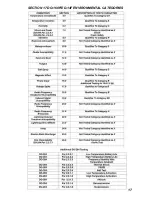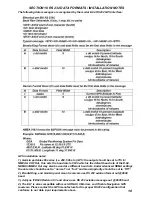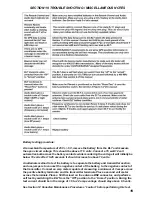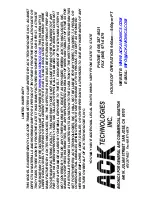
9
2.) The RCPI unit is connected to the ELT transmitter via a RJ-11 standard type modular
connectors. A 15 foot connecting cable is included with each ELT. To install the cable
connect the modular plug on the ELT transmitter into the jack end of the interconnecting
cable. Run the plug end of the cable to the audio alert unit. Run the short audio alert cable
from the RCPI to the audio alert module (page 6 Fig. 8) avoid running this cable near
sources of strong EMI/RFI radiation. (i.e. Comm cables, strobe light power cables, starter
cables.) Secure the cable along its run using tie wraps, or other suitable methods. The
interconnecting cable may be shortened, or a longer cable of up to 150ft. may be used if
necessary. After connecting the mini DIN RS 232 jack and plug. Wrap electrical tape
around the joint at the center of the connection to secure the two parts together, and seal
the joint from moisture. (Page 8 Fig. 12.5)
3.) After installation, and wiring is complete, verify that the ELT is receiving and
processing GPS data correctly. Apply power to both the ELT, and the GPS equipment
supplying data. Make sure the GPS has a satellite fix, and is reporting position data.
Fabricate a GPS verification tool as shown in figure 14.
4.) Connect the test tool as shown in Fig 14. The main switch on the ELT should be in the
“armed” position.
5.) With power supplied both to the ELT, and the GPS, make sure the GPS has acquired the
satellites, and is transmitting valid position data. The LED should blink each time the ELT
receives a valid GPS data position. (Typically once per second) This test verifies that the
ELT is properly receiving, and processing position data from the GPS system. This is a
very short duration low intensity flash make sure the LED is shielded from bright light.
6.) After verifying that the ELT is receiving, and processing GPS data correctly. Seal the
end of the GPS verification test line using a adhesive lined end cap, (McMaster-Carr
72855k21) or other method to protect it from moisture. Secure the test wire to the shielded
cable with a tie wrap.
7.) Complete the steps in section 8 (registration) before you verify the installed operation
of the ELT. After you have registered the ELT, do the self test as described in section 9 to
verify the complete system is functioning properly.
8.) Record the ELT battery expiration date marked on the ELT battery case, the expiration
of the RCPI, and audio alert batteries in the airframe logbook.
SECTION 8 REGISTRATION
1.) Before completing the final check out of the ELT,
YOU MUST FIRST REGISTER YOUR
BEACON FOLLOWING THE REGISTRATION REQUIREMENTS OF THE COUNTRY WHERE
THE AIRCRAFT IS BASED. YOU CAN ONLY REGISTER THE ELT IN THE COUNTRY THE
AIRCRAFT IS REGISTERED.
2.)
There is a preprinted self adhesive label supplied with the ELT that has the hex code,
manufacturer, and model number on it which you should affix to the top of the registration
form. Or you can refer to this label when registering over the internet. You can download the
registration forms for your country from our website.
WWW.ACKAVIONICS.COM
3.) In the U.S. and Canada you can mail or fax the registration forms, however it is strongly
recommend that beacon registration be completed on line at the following sites:
Содержание E-04
Страница 16: ...16 SECTION 16 MAJOR PARTS ...
Страница 17: ...17 SECTION 17 DO 160F ED 14F ENVIRONMENTAL CATEGORIES ...




















